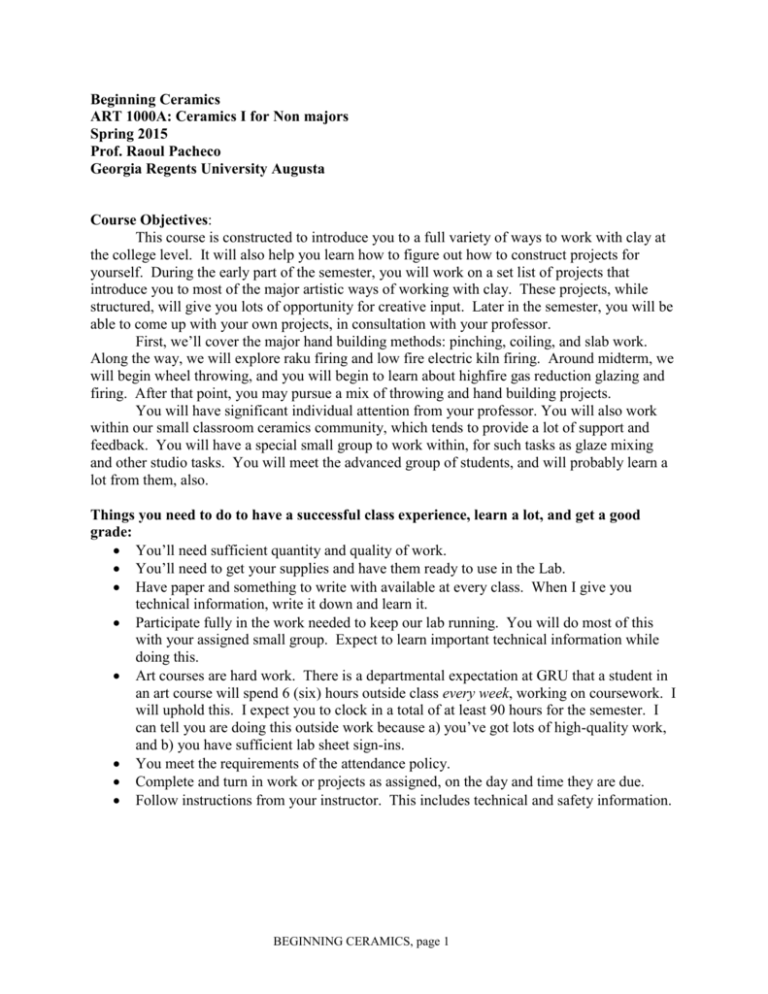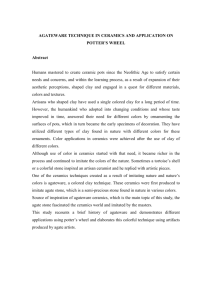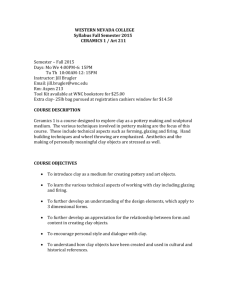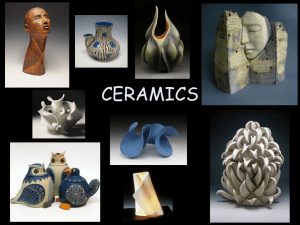Art 1000 A - Augusta University
advertisement

Beginning Ceramics ART 1000A: Ceramics I for Non majors Spring 2015 Prof. Raoul Pacheco Georgia Regents University Augusta Course Objectives: This course is constructed to introduce you to a full variety of ways to work with clay at the college level. It will also help you learn how to figure out how to construct projects for yourself. During the early part of the semester, you will work on a set list of projects that introduce you to most of the major artistic ways of working with clay. These projects, while structured, will give you lots of opportunity for creative input. Later in the semester, you will be able to come up with your own projects, in consultation with your professor. First, we’ll cover the major hand building methods: pinching, coiling, and slab work. Along the way, we will explore raku firing and low fire electric kiln firing. Around midterm, we will begin wheel throwing, and you will begin to learn about highfire gas reduction glazing and firing. After that point, you may pursue a mix of throwing and hand building projects. You will have significant individual attention from your professor. You will also work within our small classroom ceramics community, which tends to provide a lot of support and feedback. You will have a special small group to work within, for such tasks as glaze mixing and other studio tasks. You will meet the advanced group of students, and will probably learn a lot from them, also. Things you need to do to have a successful class experience, learn a lot, and get a good grade: You’ll need sufficient quantity and quality of work. You’ll need to get your supplies and have them ready to use in the Lab. Have paper and something to write with available at every class. When I give you technical information, write it down and learn it. Participate fully in the work needed to keep our lab running. You will do most of this with your assigned small group. Expect to learn important technical information while doing this. Art courses are hard work. There is a departmental expectation at GRU that a student in an art course will spend 6 (six) hours outside class every week, working on coursework. I will uphold this. I expect you to clock in a total of at least 90 hours for the semester. I can tell you are doing this outside work because a) you’ve got lots of high-quality work, and b) you have sufficient lab sheet sign-ins. You meet the requirements of the attendance policy. Complete and turn in work or projects as assigned, on the day and time they are due. Follow instructions from your instructor. This includes technical and safety information. BEGINNING CERAMICS, page 1 Things that could get in the way of your earning a good grade: Not having sufficient quantity and quality of work. Talk to your professor whenever you’re in doubt about what this means. Not turning assignments in when they are due, not following instructions. Projects will be docked a letter grade for every class day the project is late. . Not participating fully in your small group’s assigned tasks. Not meeting the attendance policy. Not working hard enough outside class/not signing in on the lab sheets by the door. The required 90 hours is what is required to receive a C for lab hours. Not responding to feedback about your work from your professor. Making work outside the Ceramics Lab and bringing it in later. The usual problem here is that your project wasn’t able to get feedback from your professor while it was in process, or it broke while you were transporting it. Avoid heartbreak, and do your work in the Lab! Doing unsafe things, hurting other people’s work, etc. Simply running out of time at the end of the semester. Plan ahead for drying and firing time! The attendance policy: University policy (see GRU catalog) states that a student should never miss more than 10% of a class. If so, the instructor may withdraw the student from the class. My attendance comments: You should never miss class. University policy permits only three studio class absences per semester. I reserve the right to drop you from class for excessive absenteeism. I guarantee I will deduct points from the final class average for EVERY ABSENCE OR TARDY beyond three. Punctuality is part of attendance also. Two tardies will equal one absence. I take roll every day. If you do miss class, you are responsible for any projects assigned, any demonstrations missed (which will not be repeated), or any assignments/artwork presented that day. Projects that are turned in late, regardless of reason, WILL DROP HALF A LETTER GRADE PER DAY LATE. Do not miss class on a demonstration or critique day. They cannot be made up. If, at my discretion, I were to allow you to remain in the course after 3 absences, there would also be a grade penalty. A word about preparation: Come to class prepared to participate. Don’t leave your materials in your car, etc. The positive reason for this policy: you can’t learn fully unless you’re there in class, participating, listening, learning, and doing the work. Lab access: The ceramics studio is available to students currently enrolled in an ASU ceramics course at any time during the semester except when other classes are in session. This semester, Advanced Ceramics as well as a second Beginning Ceramics section (taught by Suzette Hollins) also meet in the Ceramics Lab. You may NOT work during these classes. After hours (generally after 5:00 p.m. and on weekends), you can gain access by calling Public Safety (737-1401). Public Safety requires that at least two people be present at all times in the studio (sculpture and ceramics). BEGINNING CERAMICS, page 2 Useful contact information: Public Safety 706 737-1401 Ceramics/Sculpture Lab phone: 706 737-1789 Art Department Office: 706 667-4888 Raoul’s office 145 Washington Hall Raoul’s office: 706 667-4871 (You can leave messages at this number.) Raoul’s email: rpacheco@gru.edu (usually the best way to leave me a message) Brian Fort at Fort Pottery Co.: 706 799-2296 Rules for safety and professional courtesy: 1. Do not operate equipment if you have not been trained to use it. 2. The clay mixer, kilns and pug mill cannot be used without specific permission from your professor. Clay can only be mixed in the presence of an instructor, unless I give you specific permission. 3. Do not create unnecessary dust. Clay dust is hazardous. If you must sweep, sweep gently. Wiping up dust with a damp sponge is a safe and convenient way to clean. This is the recommended method for cleaning. 4. Be aware when kilns are firing and use necessary caution around them. Do not operate kilns unless you have been cleared to do so by your professor! You must gain specific clearance to fire the electric kilns or the raku kiln from your professor each and every time you wish to fire. Students may not fire the highfire gas kiln without proper training (however, I encourage anyone and everyone to help fire the gas kiln under the supervision of your professor). 5. Be as “green” as possible in the Ceramics Lab. Recycle aluminum drink cans by placing them in the blue recycle bin. Put reusable clay back in the barrel so that someone else can use it – and keep the lid on the barrel. If the clay is too dry or too wet to use, but has not been fired yet, put it in a recycle barrel in the clay mixing room. Be careful about heat and air conditioning – don’t open the big door if the heat or A.C. is on. Vent fans in the clay mixing room and for the electric kilns should be turned off when they are not in use. 6. Shoe rule: At all times while in the Ceramics Lab, you will need to wear appropriate footwear. Closed-toe shoes are required. No bare feet, of course. The lightest shoe that will meet the policy is a clog that is closed at the toe area but open in the back. Work boots are wonderfully appropriate. A good plan is to leave a pair of work boots and socks (clean socks!) in your locker so that you always have them. When firing the Raku kiln, you should wear shoes that would protect your feet if you dropped a hot object straight from the kiln on them. Be aware that the shoe policy in the Sculpture Lab is more stringent – only completely closed shoes are allowed there (closed at toe and heel and in between). 7. Always clean up after yourself. Don’t leave clay or water on the floor - this is a very slippery combination. After using the glazing area, leave it clean. Do not leave your work sitting on a wheel if you are not using it. 8. After using a wheel, leave it clean. If you have made a big mess on the floor, clean it up with BEGINNING CERAMICS, page 3 4 a wet sponge. Turn off electric wheels after you have finished using them. *Leaving messes after you have been warned about this problem can result in substantial penalties. 9. Report damage to your professor immediately. After hours, call Public Safety if the situation is at the emergency level. 10. Do not mix up any new or unknown clay or glaze recipes without clearing this first with your professor. Do not add any materials to your clay that are not in the recipe without clearing this with your professor first. This is a very serious rule! 11. Only those who are currently enrolled in GRU ceramics classes have the right to be in the Ceramics Lab. If the presence of someone who is not supposed to be here is making you feel unsafe or uncomfortable, you have the right to call Public Safety and have that person removed. (As an alternative, you may wish to discuss the problem with your professor later if the situation is not an emergency.) 12. Party elsewhere. Your instructor reserves the right to withdrawal you from the course if this rule is broken. 13. If you are throwing away something heavy, take it outside and put it in the dumpster. 14. Honor other people’s work – don’t touch it when it’s in a fragile state or without permission, and don’t allow your family or friends to do so. 15. When the semester is over, it’s over. All your work is due on the last day of class, finished and with glaze on it. Many projects will have been due earlier in the semester. Exam period is the time when your instructor is firing kilns and grading your work – you may not use it to make more pieces in clay. 16. Your instructor reserves the right not to fire pieces that don’t meet technical specifications. For instance, forms that are too thick to fire safely, forms with flammable inclusions (such as paper or plastic), thrown forms that are not trimmed, any forms that don’t meet basic quality standards. 17. When the semester is over and grading is finished, remove your work and possessions. Anything of yours still remaining in lab after final exams are over is the property of your professor, and he will dispose of it so that the next class may use the space. 18. Do your best to keep clay out of the sinks. Our plumbing is poor, and it needs to be babied. When the sinks back up, tell your instructor (or you can call Physical Plant at 706 7371590). 19. Be careful to keep plaster and cement out of the clay supply. These substances cause the clay to explode or blow out in firing. 20. It’s great to learn from other students, but try to respect the time of others. Remember, they need their class time and work time also. It’s fine to call your professor or ask her in person when you have questions. 21. No Food or Drink allowed in the lab. There is a break room in the sculpture studio for eating and drinking. BEGINNING CERAMICS, page 4 5 Supplies: Your supply fee goes towards buying your clay and the shop glazes that we mix up. You will need to buy your own personal tools. This is the basic toolkit: $45 purchased from Fort Pottery 1 sketchbook/notebook, Plus something to write and draw with. 1 ceramic toolkit containing small sponge, large and small loop tool, wooden rib, metal rib, wooden knife, cutting wire and needle tool. 1 fettling knife 1 large sponge for cleanup 2 bamboo brushes #4 and #8 . Brushes for painting in oil or acrylic don’t work very well for ceramics because they are meant for stiff paint, whereas you will be working with fluid glazes. Instead, use oriental bamboo-style brushes – they are designed for use with fluids. 1 bucket for throwing and to store your tools in. It would be smart to get a small bucket that will fit in a locker. 1 metal dinner fork (plastic breaks on clay). 10 plastic bags to keep your work wet. Garbage bags are good, shopping bags are bad. Optional: a barbecue apron to keep your clothes clean (or maybe a pair of overalls or a mechanic’s jumpsuit if you prefer). A bath towel to keep your legs clean while throwing. Hand lotion. A lock if you plan to use a locker. Crocs-type shoes that you keep in your locker. A textbook would be handy (Hands in Clay by Speight and Toki is a good one). Class assignments: Note: exact specifications for these projects will be discussed in class, including due dates. As due dates are announced, you should write these in your sketch book. There will be due dates for building as well as glazing and firing. Hand building Pinching: 9 handheld pots or sculptures. Try to avoid flat bottoms on the pots. 2 that are very spherical in form. (One of these forms will be burnished for the pit fire assignment; I will lead you through this process) 1 that exploits finger marks 1 that is carved (carving, not surface scratching!) 1 that is not very symmetrical 1 with protrusions (use your imagination) 2 with surface texture. 1 that is two or more pinched forms scored, slipped and combined to create one form. BEGINNING CERAMICS, page 5 6 Coiling: One form at least 12" tall. Narrative/ Imagery Vessel. (Requires research: go to the library and bring in 4 photocopies and 5 drawings of forms that interest you - anything with volume). I recommend choosing a form from a different culture. One form at least 20" tall. Figurative influenced You can flip flop size requirements. For your coil projects you are required to turn in 6 2x4 inch Test tiles for low fire. This process is to help you better understand the glazes. Slab Building: First: a container with a lid (not your usual container – this box will have an unusual shape and/or special decoration). Second: A form with architectural references. One of these projects must utilize the circle-o-matic template system. Wheel Work/ Throwing Introductory throwing (“pet food bowls” – your first bowls might be very thick and somewhat uneven) Bowls (more accomplished ones) Cups and mugs (mugs have handles) Cylinders (this makes your throwing easier and dramatically more skillful). Pitchers (more advanced) Possible assignment. Set of bowls (more advanced) Possible assignment. Required throwing projects. 3 x 6 inch cylinder from 1.5 to 2lbs of clay, trimmed and glazed 3 well trimmed bowls 1 to 1.5 lbs of clay One coffee cup with handle. Personalized drinking vessel BEGINNING CERAMICS, page 6 7 More Advanced Hand building (these are possible assignments only) – Self-portrait: Build a life-size head-and-shoulders portrait of yourself. Build it in a definite art style from the past or from another culture, such as Ife, Cubist, Inca, Post-Impressionist, Surrealist, Egyptian, etc. (Do research!). Don’t use a mirror or a photo of yourself while making the piece. Why did you pick the style you did? Why does it interest you? What does it express about you? Landscape in a bowl: Build a good-sized bowl (15-20" perhaps). Inside the bowl, construct a landscape. What kind of landscape, and why? Consider the relation between the shape of the bowl and the form and the meaning of the landscape. (Reference drawings and images are necessary.) Fantasy teapot set: Build a teapot and several other elements such as creamer and sugar containers, teacups and saucers, perhaps a tray. All of the elements should be designed to go together. The set could be functional or nonfunctional. The design should be unusual. If you would never use a teapot, the design could be ironic - or perhaps you will choose to design a pitcher and a set of beer steins (be sure to emphasize the fantasy element either way). What does the design of your set say about the life you’d like to have or the occasion when you’d need to have a set like this on hand? Grading The course grade is determined by these factors: quality of your artwork (the aesthetics of your projects, creativity, evaluation of projects, etc.) work habits (good use of class time, evidence of at least 6 hrs./wk. out of class, perseverance, participation during critques.) technical skill & aptitude (shows grasp of processes and continual improvement, increasingly skillful manipulation of materials, etc.) Ceramic studio upkeep and practice (following shop rules; safe, considerate use of shop materials and spaces) Written test & quiz grades excessive absences or tardiness will effect your grade Keep an amazing notebook/sketchbook You will be required to turn in your sketchbook/notebook/journal at the end of the semester. This book should be a tool for exploring your own ideas as well as a record of research and inquiry. You should record the thoughts, challenges and triumphs of every workday. DUE DATE Feb 26th and April 28th BEGINNING CERAMICS, page 7 8 Your notebook: during this semester, we will be using the notebook as an integral and crucial part of the course. You are required to make a journal entry for every work session you have with clay (i.e., every class and every outside clay work session). Record your progress, your hopes, your plans, what are your successes and your failures and what has been learned from your working processes. Include drawings, technical notes from class, handouts, clippings, and anything else you find interesting and pertinent to the course. Research project and presentation: Using PowerPoint and digital images, you will present an artist or visual idea related to ceramics to the class. This project will require research, which is often done by searching the Internet or going to library. There will be preliminary stages required in this project at various intervals. We will run three to four presentations in the first hour of class starting on the dates below. Presentation Dates = Feb 24rd, Feb 26th, March 3rd, March 5th, March 10th Technical Mixing clay and glazes Testing and learning to use all of the shop glazes. Raku firing process Studio upkeep. You will also be responsible for mixing a shop glaze. I will teach you this process in class. You will be paired up with a partner and a due date will be established after the glaze lecture. Please note: If any student needs special accommodations because of a disability, please make an appointment to see the Director of Disability Services. Testing and Disability Services is located in the quadrangle and the phone number is (706) 737-1469. BEGINNING CERAMICS, page 8 9 My team number is Team members: TEAM 1: TEAM 2: TEAM 3: TEAM 4: BEGINNING CERAMICS, page 9








![[1.1] Prehistoric Origins Work Sheet](http://s3.studylib.net/store/data/006616577_1-747248a348beda0bf6c418ebdaed3459-300x300.png)